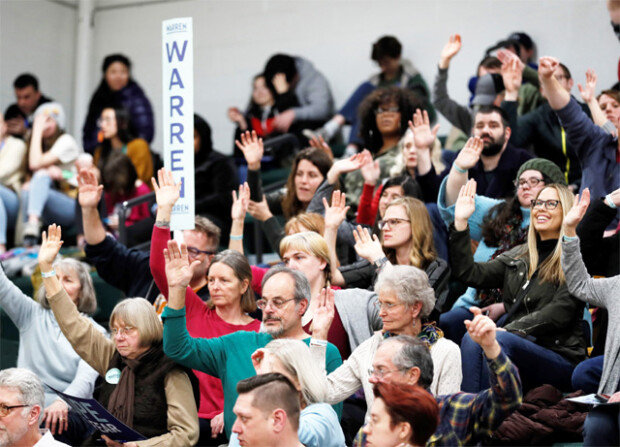Why does U.S. still have outdated indirect election system?
Why does U.S. still have outdated indirect election system?
Posted February. 19, 2020 07:58,
Updated February. 19, 2020 07:58

Looking at the U.S. presidential election, which will take place in nine months, can easily make me zone out. Election-related terms, such as “pledged delegates,” “winner-takes-most,” “satellite caucus,” and “closed primary,” make my head spin and the indirect election system in dual structure is also very complicated. In this technologically-advanced era, why does the U.S. still maintain an indirect election system, which can cause wasted votes and the distorted representation of public opinions?
I was able to guess the reasons by witnessing the campaigns held by the ruling Republican and opposition Democratic parties in Iowa and New Hampshire on February 3 and 11, respectively.
Compared to major cities in the East and West coasts, such as New York and Los Angeles, the above locations seem deep in the countryside. In addition, both current U.S. President Donald Trump and Democratic candidate Bernie Sanders with a leading approval rating are from New York, the largest city in the country. Former mayor of New York City Michael Bloomberg is also originally from Boston.
The only major candidate from the countryside is Pete Buttigieg, born and raised in South Bend, Indiana, which is a small city of 100,000 populations. Even he has spent most of his adult years in large cities, attending Harvard University in the suburb of Boston and working at the Chicago office of McKinsey & Company.
What would happen if large-scale political events didn’t take place in non-major cities when most presidential candidates to represent 330 million U.S. citizens are from a few major cities? The marginalization of states with relatively small populations will become worse. Voters would have no opportunity for more personal interaction with candidates and the media will lose interest, perhaps representing Iowa and New Hampshire simply as the places famous for corn and autumn leaves.
This is in line with ensuring at least three electors per state regardless of the size of a state, instead of dividing the presidential electoral college of 538 electors proportionally based on populations. The most populous state, California, has 68 times more populations than the least populated state, Wyoming, but the numbers of electors are 55 and three, respectively, only 18 times difference between the two.
U.S. citizens believe that the current presidential election system is a way to expand points of contact between candidates and voters in the large country, as well as the foundation of “checks and balances” to ensure larger states do not have excessive control over important national matters. This explains why primaries for a presidential election begin in Iowa and New Hampshire, which are far from Washington D.C., and why not many people have been calling for a faster, more transparent, and more efficient direct election system even after a major delay in ballot counting in the Democratic Party’s Iowa caucuses. This is also why an indirect election system, which seems to be against democracy, has been kept for over 240 years despite various issues and why the 2nd amendment protects the system.
As populations will be even more concentrated in a few numbers of large cities due to the development of the means of transportation and communication, the current election system will be maintained for a while to protect small states’ rights.
Moreover, the biggest reason behind the long history of an indirect election system may be the social structure in the U.S., in which the changes of the presidential election process and a ruling party do not lead to a complete shake-up of various systems, laws and regulations. This is what I think as a foreign national who pays closer attention to U.S. presidential election than average Americans.
Jung-Min Ha dew@donga.com




![용산 대통령실 사우나와 비밀통로[횡설수설/신광영]](https://dimg.donga.com/c/138/175/90/1/wps/NEWS/IMAGE/2026/01/04/133090799.1.jpg)
![가습기 대신 젖은 빨래?…폐에 ‘곰팡이 균’ 키운다 [알쓸톡]](https://dimg.donga.com/c/138/175/90/1/wps/NEWS/IMAGE/2026/01/02/133040702.3.png)

